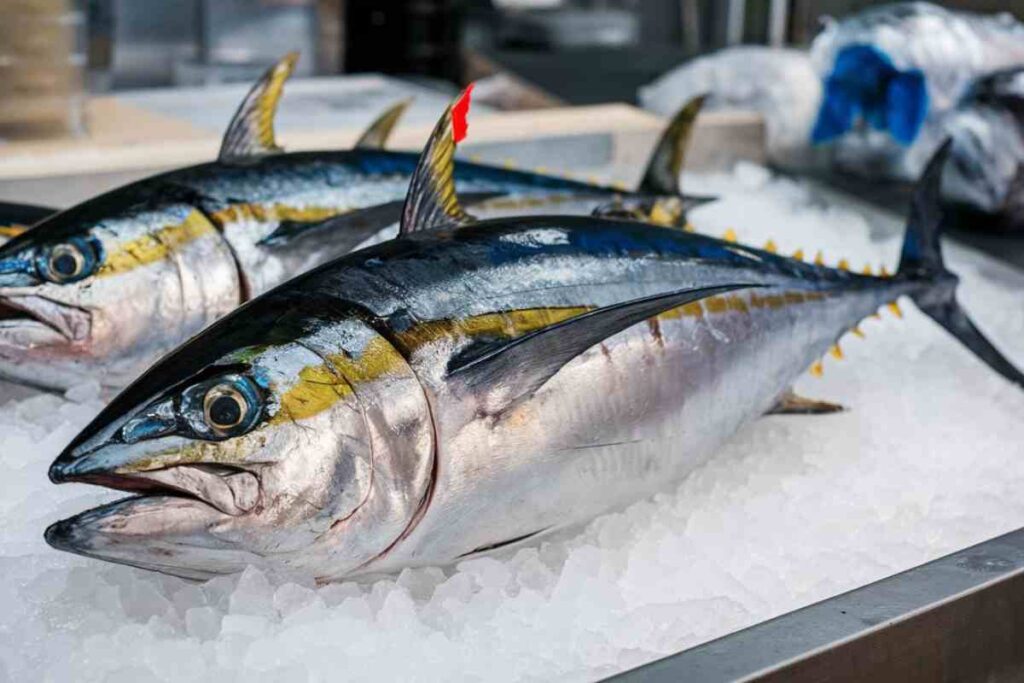- What Makes тунец длиннопёрый Unique?
- Albacore Tuna Nutrition
- Cooking Albacore Tuna (тунец длиннопёрый)
- Health Considerations and Safety
- Albacore Tuna vs. Ahi Tuna: How Do They Compare?
- Conclusion
- FAQs
- What is the difference between “тунец длиннопёрый” and other types of tuna?
- What is the best way to thaw frozen “тунец длиннопёрый” safely?
- How can you tell if “тунец длиннопёрый” is fresh?
- Can you eat “тунец длиннопёрый” raw without freezing it?
- How does “тунец длиннопёрый” compare nutritionally to other fish?
- What are some common seasoning options for “тунец длиннопёрый”?
Albacore tuna, also known as “тунец длиннопёрый” or longfin tuna, is a remarkable fish prized for its mild flavor, nutritional value, and versatility in the kitchen.
Found in warm and temperate waters around the globe, this tuna species is not only a favorite for canning but is also delicious in fresh and frozen forms.
Let’s explore why albacore tuna is a standout choice for seafood lovers.
What Makes тунец длиннопёрый Unique?

Albacore tuna, or “тунец длиннопёрый,” is a standout species within the tuna family. It is celebrated for its distinctive qualities.
Here’s why:
Light Color and Firm Texture
Unlike many other tunas, which can be deep red, albacore tuna has a lighter, pinkish-white hue.
This makes it especially appealing for dishes where presentation matters, such as sushi and sashimi.
Its firm texture also makes it versatile; it holds together well whether served raw, seared, or grilled, giving it an edge over softer types of tuna.
Delicate Flavor Profile
Albacore has a milder taste compared to other tunas, like yellowfin or bluefin. Its subtle, less “fishy” flavor is often preferred by people who are new to eating raw fish or are trying tuna for the first time.
This delicate flavor allows it to pair well with various seasonings, marinades, and side dishes, making it an adaptable option in both Western and Asian cuisines.
Versatile Cooking Options
Due to its firm texture and mild taste, albacore tuna can be prepared in many ways. It’s commonly used for sushi and sashimi but is also ideal for grilling, searing, and even canning. This versatility makes it a popular choice among home cooks and professional chefs alike.
Sustainably Sourced and Wild-Caught
Albacore tuna is typically caught wild in clean, open ocean waters from the Pacific regions, including areas around Hawaii and the South Pacific.
Because it is generally harvested from well-managed fisheries, it can be a more sustainable choice than other tuna species.
Strict Quality Control
Reputable seafood suppliers ensure that albacore tuna (тунец длиннопёрый) is handled with great care from the moment it is caught.
It is usually flash-frozen immediately after being harvested, which preserves its freshness, texture, and flavor.
This rapid freezing also helps lock in nutrients, allowing consumers to enjoy a high-quality product, whether buying it fresh or canned.
Albacore Tuna Nutrition
One of the biggest advantages of albacore tuna (тунец длиннопёрый) is its high nutritional content. Here’s what makes it an excellent addition to a balanced diet:
Omega-3 Fatty Acids
Rich in heart-healthy omega-3s, albacore tuna supports cardiovascular health, lowers inflammation, and is even thought to reduce the risk of certain cancers.
High Protein, Low Fat
Each serving of albacore tuna is packed with protein, making it a lean and filling option. With fewer calories and half the fat of poultry or beef, it’s ideal for those managing their weight.
Essential Nutrients
Albacore is high in B12, selenium, and other vital vitamins and minerals, essential for energy production and immune function.
Cooking Albacore Tuna (тунец длиннопёрый)

Albacore tuna’s (тунец длиннопёрый) firm texture and mild, delicate flavor make it ideal for a variety of cooking methods, each bringing out the fish’s unique qualities.
Here are some popular techniques and flavor pairings to elevate your dish:
Grilling
Grilling albacore tuna imparts a subtle smokiness and savory depth that complements its mild flavor.
The firm texture of albacore makes it an excellent choice for grilling, as it holds together well over high heat.
To enhance the natural taste, marinate the fish briefly in olive oil, garlic, lemon juice, and fresh herbs such as thyme or rosemary.
For an added burst of flavor, you can finish with a drizzle of balsamic reduction or a sprinkle of sea salt.
Seared Tuna Steak
Searing albacore tuna creates a flavorful crust on the outside while keeping the inside tender and moist.
Start with a hot skillet or grill pan, add a touch of high-heat oil (like avocado or sesame oil), and sear each side for about 1-2 minutes.
The result is a lightly crisped exterior with a delicate, slightly rare center.
To finish, you can top the seared tuna with a sesame or soy-based glaze or sprinkle it with toasted sesame seeds and sliced scallions for an Asian-inspired twist.
Smoked Albacore
Smoking albacore tuna enhances its natural richness with a subtle sweetness that works beautifully in salads, sandwiches, or as a savory snack.
Smoked albacore is often infused with hints of wood smoke (such as apple or cherry wood) that pair well with ingredients like capers, lemon zest, or a mild aioli.
Serve it with crackers or incorporate it into a charcuterie board for an elegant appetizer.
For Sushi and Sashimi
Albacore tuna is a great alternative to the more expensive bluefin or yellowfin tuna for sushi and sashimi lovers.
It provides a similar buttery texture and mild flavor, making it delicious for sushi rolls or topping rice in nigiri.
Pair it with wasabi, soy sauce, and pickled ginger, or enjoy it with a touch of ponzu sauce for a citrusy kick.
Health Considerations and Safety
While albacore tuna (тунец длиннопёрый) offers significant nutritional benefits.
As with many types of fish, mercury content should be considered when evaluating high-quality protein, omega-3 fatty acids, and essential vitamins.
Albacore tuna naturally contains trace amounts of mercury, a mineral that, in higher concentrations, can impact health over time.
Guidelines for Consumption
- Moderation is Key
For adults, including pregnant and nursing women, moderate consumption of albacore tuna—around one serving per week—balances safety with nutritional benefits.
This level aligns with most health guidelines, ensuring that the intake remains well within safe limits. - Wild-Caught Albacore Benefits
Wild-caught albacore tuna, especially from open and clean ocean waters, tends to have lower mercury levels.
Reputable suppliers carefully source and handle wild albacore, ensuring its quality and safety for consumers. - FDA Guidelines
Mercury levels in albacore tuna are typically below the FDA’s safety threshold, which is reassuring for those who enjoy it as a regular part of a balanced diet.
This makes it a nutritious option for those seeking omega-3 benefits without excess exposure to mercury.
Albacore Tuna vs. Ahi Tuna: How Do They Compare?

While albacore tuna (тунец длиннопёрый) is mild and lean, ahi tuna (yellowfin tuna) is higher in fat with a richer, deeper flavor.
Ahi is often the top choice for sashimi because of its vibrant red color and softer raw texture.
However, albacore’s affordability and lower fat content make it a popular option for those who enjoy sushi on a budget.
Conclusion
“тунец длиннопёрый” (albacore tuna) is a versatile and nutrient-rich choice that brings both flavor and health benefits to any meal.
Whether enjoyed grilled, seared, smoked, or raw in sushi, albacore tuna offers a delicate taste, firm texture, and high levels of essential nutrients like protein and omega-3 fatty acids.
While it’s a more affordable alternative to some tuna varieties, it delivers the same quality and satisfaction.
With mindful consumption, especially for those concerned about mercury, albacore tuna is a safe and delicious way to add valuable nutrition to your diet.
For quality assurance, opt for responsibly sourced and quickly frozen albacore from trusted suppliers, ensuring the best flavor and safety.
FAQs
What is the difference between “тунец длиннопёрый” and other types of tuna?
“Тунец длиннопёрый,” or albacore tuna, is lighter in color and has a milder flavor compared to other varieties, such as yellowfin or bluefin. It’s also commonly used for canning due to its texture and flavor.
What is the best way to thaw frozen “тунец длиннопёрый” safely?
The safest way to thaw frozen albacore tuna is by placing it in the refrigerator for several hours or overnight. Avoid thawing it at room temperature to maintain freshness and reduce the risk of bacteria.
How can you tell if “тунец длиннопёрый” is fresh?
Fresh albacore tuna has a mild scent and firm, moist flesh with a pinkish color. If it smells overly fishy or has a dull color, it may not be fresh.
Can you eat “тунец длиннопёрый” raw without freezing it?
For safety, it’s best to consume only sushi-grade albacore tuna raw, as it has been handled and frozen specifically to kill parasites. If you plan to eat it raw, ensure you purchase from a reputable source.
How does “тунец длиннопёрый” compare nutritionally to other fish?
Albacore tuna is high in protein, low in fat, and rich in omega-3 fatty acids, which benefit heart and brain health. It also has fewer calories than fatty fish like salmon.
What are some common seasoning options for “тунец длиннопёрый”?
Albacore tuna pairs well with seasonings like lemon, garlic, soy sauce, black pepper, and herbs like dill and basil. Marinades with citrus or teriyaki flavors complement its mild taste.




